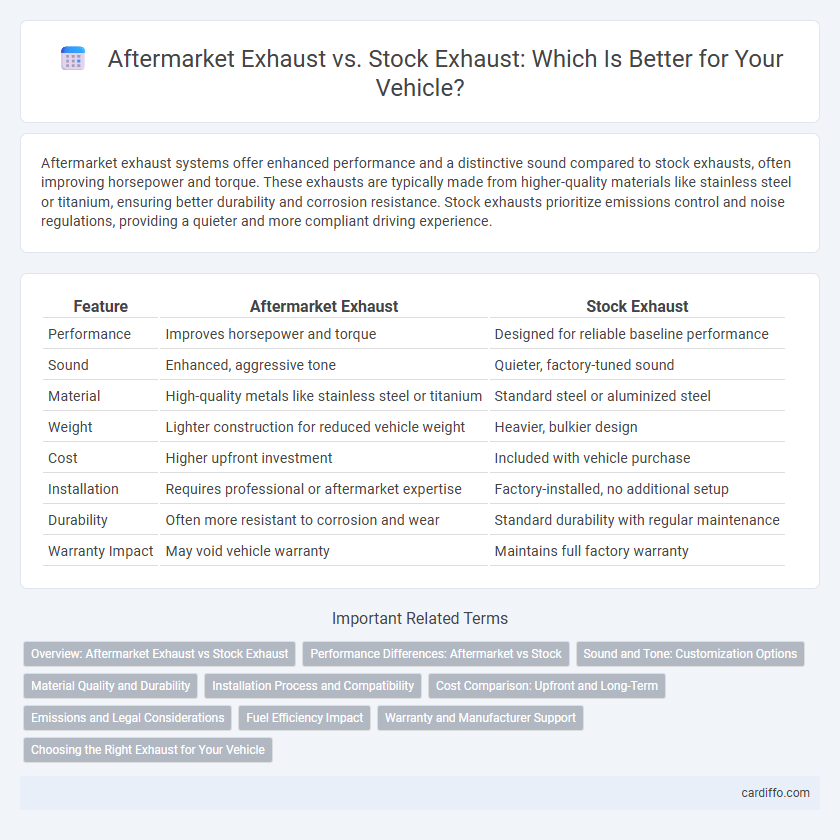Aftermarket exhaust systems offer enhanced performance and a distinctive sound compared to stock exhausts, often improving horsepower and torque. These exhausts are typically made from higher-quality materials like stainless steel or titanium, ensuring better durability and corrosion resistance. Stock exhausts prioritize emissions control and noise regulations, providing a quieter and more compliant driving experience.
Table of Comparison
| Feature | Aftermarket Exhaust | Stock Exhaust |
|---|---|---|
| Performance | Improves horsepower and torque | Designed for reliable baseline performance |
| Sound | Enhanced, aggressive tone | Quieter, factory-tuned sound |
| Material | High-quality metals like stainless steel or titanium | Standard steel or aluminized steel |
| Weight | Lighter construction for reduced vehicle weight | Heavier, bulkier design |
| Cost | Higher upfront investment | Included with vehicle purchase |
| Installation | Requires professional or aftermarket expertise | Factory-installed, no additional setup |
| Durability | Often more resistant to corrosion and wear | Standard durability with regular maintenance |
| Warranty Impact | May void vehicle warranty | Maintains full factory warranty |
Overview: Aftermarket Exhaust vs Stock Exhaust
Aftermarket exhaust systems often provide enhanced performance, improved sound, and customized aesthetics compared to stock exhausts, which are designed primarily for compliance and durability. Stock exhausts prioritize emissions control and noise regulations, ensuring factory-level reliability and warranty coverage. Choosing between aftermarket and stock exhausts depends on desired vehicle performance, sound preferences, and legal requirements.
Performance Differences: Aftermarket vs Stock
Aftermarket exhaust systems typically enhance vehicle performance by improving exhaust flow, reducing back pressure, and increasing horsepower and torque compared to stock exhausts designed for emissions and noise control. They often utilize high-quality materials like stainless steel or titanium, contributing to weight reduction that further boosts acceleration and fuel efficiency. In contrast, stock exhaust systems prioritize durability and compliance with regulations, which can limit performance gains.
Sound and Tone: Customization Options
Aftermarket exhaust systems offer a wide range of sound and tone customization options, allowing drivers to achieve deeper, louder, or more aggressive exhaust notes compared to stock exhausts, which are typically engineered for quieter, more uniform performance to meet noise regulations. Many aftermarket systems incorporate high-flow mufflers, resonators, and varying pipe diameters that enhance exhaust sound quality and vehicle character. Customizable components like adjustable mufflers or resonator deletes enable tailored sound profiles that stock exhausts cannot provide.
Material Quality and Durability
Aftermarket exhaust systems often feature premium materials such as stainless steel or titanium, offering enhanced corrosion resistance and longevity compared to standard stock exhausts typically made from mild steel. These high-grade materials in aftermarket options improve heat tolerance and structural integrity, resulting in superior durability under extreme conditions. Stock exhausts, while cost-effective, generally provide lower resistance to rust and wear, necessitating more frequent replacements over time.
Installation Process and Compatibility
Aftermarket exhaust systems often require modifications during installation and may need professional expertise to ensure proper fitment and performance, whereas stock exhausts are designed for direct bolt-on installation with guaranteed compatibility. Compatibility issues can arise with aftermarket exhausts due to variations in vehicle models, requiring careful selection based on make, model, and year to avoid fitment problems. Stock exhausts maintain factory specifications, ensuring seamless integration with existing vehicle components and emission systems.
Cost Comparison: Upfront and Long-Term
Aftermarket exhaust systems typically have higher upfront costs compared to stock exhausts but offer potential long-term savings through improved fuel efficiency and enhanced vehicle performance. Stock exhausts are generally more affordable initially and designed for optimal emissions compliance and durability, minimizing maintenance expenses over time. Evaluating total cost of ownership involves balancing the initial investment of aftermarket parts against the predictable, lower maintenance costs associated with original stock components.
Emissions and Legal Considerations
Aftermarket exhaust systems often alter emissions output by modifying the vehicle's catalytic converters and oxygen sensors, potentially causing non-compliance with Environmental Protection Agency (EPA) standards and state regulations. Stock exhausts are engineered to meet strict emissions criteria, ensuring legal operation and reducing harmful pollutants like nitrogen oxides and carbon monoxide. Vehicle owners must verify that aftermarket exhausts have proper certifications, such as CARB EO numbers, to avoid fines and ensure road legality.
Fuel Efficiency Impact
Aftermarket exhaust systems typically improve fuel efficiency by reducing backpressure and enhancing exhaust flow compared to stock exhausts, which are designed primarily for noise control and emissions compliance. Enhanced oxygen flow and better engine breathing in aftermarket setups can lead to a modest increase in miles per gallon, especially in performance-oriented vehicles. However, the actual fuel efficiency gains depend on the exhaust design, installation quality, and vehicle compatibility.
Warranty and Manufacturer Support
Aftermarket exhaust systems often come with limited or no manufacturer warranty, which can affect coverage if vehicle issues arise. Stock exhausts are fully supported by the vehicle manufacturer, maintaining full warranty protection and ensuring compliance with emissions regulations. Choosing a stock exhaust guarantees seamless manufacturer support and preserves warranty benefits for engine and related components.
Choosing the Right Exhaust for Your Vehicle
Selecting the right exhaust system enhances vehicle performance, sound, and fuel efficiency. Aftermarket exhausts offer customizable options with improved airflow and aggressive tones, while stock exhausts ensure compliance with manufacturer specifications and emissions standards. Prioritize compatibility with your vehicle model, driving style, and local regulations to achieve optimal results.
Aftermarket exhaust vs Stock exhaust Infographic

 cardiffo.com
cardiffo.com